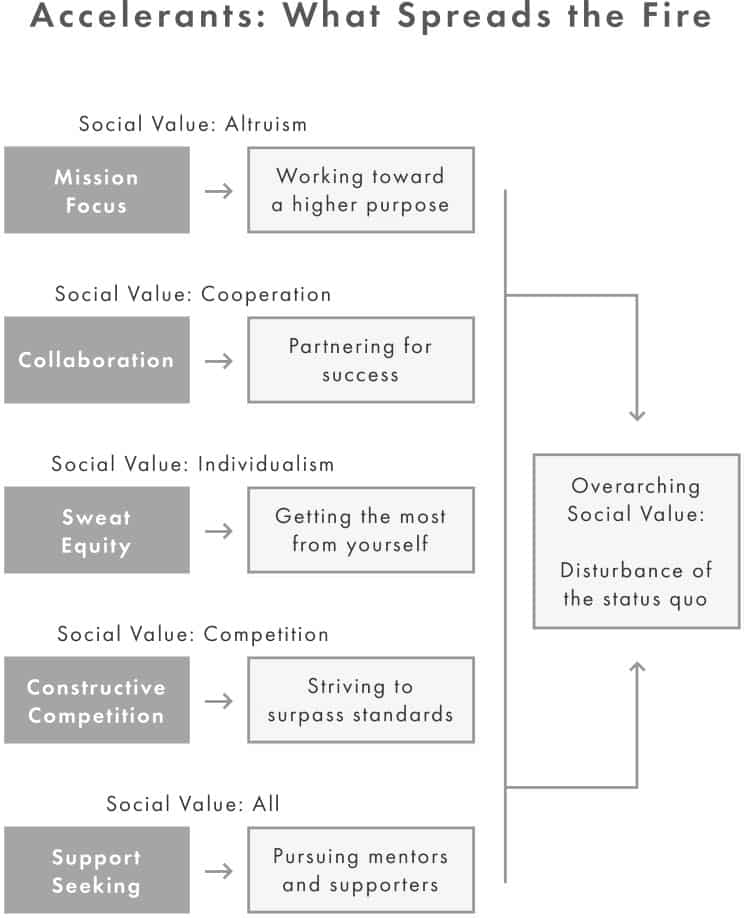Accelerating Your Organization Through a Socially Balanced Strategy

Corporations are complex social entities, whether they are establishing a social media presence or simply marketing a brand with which people will fall in love. How do their ideas catch fire? What accelerates growth and customer acquisition? What makes employees passionate about the mission? We believe the answer lies in social balance.
Common social orientations of people and organizations include: altruism, collaboration, individualism, competition, and disturbance of the status quo. Each of these orientations acts as an Accelerant, and CEOs have the power to press the gas pedal. Focusing on any one of these orientations provides your organization with marketing and affiliation advantages. People who are altruistic are attracted to altruistic organizations. People who are competitive are attracted to competitive organizations. However, organizations are not constrained to focus on only one of these Accelerants. When an organization strategically addresses all five orientations, it adopts what we call a socially balanced strategy, and it arms itself for exponential growth.
Why is it necessary to take a socially balanced approach? Modern workers and customers expect to see their values reflected in the organizations with which they interact. When there is a gap, they notice. An organization must address this gap by establishing socially balanced strategies that let employees and customers collectively feel the most buy-in to the mission and initiatives.
The following chart shows how social values work together as Accelerants to spread an organization’s reach.
Source: Firestarters: How Innovators, Instigators, and Initiators Can Inspire You to Ignite Your Own Life
With these Accelerants in mind, here are six questions you can ask to help your organization pursue a socially balanced strategy.
1) What is your altruistic advantage?
Organizations’ brands are now intimately intertwined with the idea of a larger mission focus. They find charities and causes that they can proudly support and integrate the cause into their strategies and marketing efforts. Look at the vast swaths of pink that adorn companies throughout the month of October, from retail outlets to the National Football League, in support of breast cancer awareness. It is now an expectation at several organizations to have selections of pink products and accessories. Support for a cause has become consumed by the brands to such an extent that people thinking about breast cancer awareness often think about the associated organizations simultaneously.
2) What is your cooperative advantage?
Partnerships are a necessity for mutually assured success of multiple organizations. The key to a cooperative partnership is that both entities consciously enter into the arrangement to strengthen their position. Think of organizations like Walmart and Costco that partner with manufacturers to develop exclusive products that drive consumers to their stores and websites. Larger organizations with multiple internal branches must also find ways for their own directorates to support and flourish with joint strategies.
3) What is your individualist advantage?
Individualism is about leveraging key strengths both internally and externally. Google’s original 70-20-10 model is an example of a successful execution of an individualist strategy to capitalize on employee strengths. In addition, think about the app development industry where an entire stratosphere of services would not be possible without businesses exploiting Apple and Android platforms. The individualist advantage lies in finding ways to capitalize on existing infrastructure and available skillsets.
4) What is your competitive advantage?
Organizations do not live in a vacuum and must remain viable when competing for resources and customers. While we facilitated a recent strategic planning session with a non-profit organization, the Board realized they were in competition for money and customers from other similar non-profits. They decided to adjust their strategy from a pure altruistic focus to make their services more price-competitive. Altruism and competition can co-exist.
5) What is your disturbance advantage?
It is one thing to be competitive and quite another to disturb the status quo. Disturbance implies an active “tearing down and rebuilding” of the way business is done. For example, Uber’s original business model destroyed previously established practices – it did not compete with them in the traditional sense. Disturbance is key for any organization that plans to become the industry standard. A company won’t change the status quo by simply striving to remain competitive.
6) Do you actively seek support for employees and customers?
Creating a socially balanced organization requires seeking the right levels of mentoring and support for both employees and customers. For example, scores of leading companies have committed to the Paradigm for Parity® 5-Step Action Plan, designed to increase the number of women in corporate leadership positions. Mentoring and support are clearly outlined in this action plan. Other types of support include providing needed employee development resources and establishing practices for effectively guiding customers through their journey with your organization.
In a world where organizations are active social entities, CEOs must understand the social context of performance. Relying on competitive advantages alone (or any other single type of advantage) may undercut or even kill your true advantage. Instead, an organization can establish advantages across the social spectrum and capitalize on the collective package of advantages to accelerate its success.
This article is contributed by Paul Eder PhD, Kathy Palokoff, and Raoul Davis. The views expressed in this article are those of the author alone and not the CEOWORLD magazine.
[starbox id=3110]
[starbox id=3109]
[starbox id=2226]
Together, they are the authors of the new book FIRESTARTERS: How Innovators, Instigators, and Initiators Can Inspire You to Ignite Your Own Life.
Add CEOWORLD magazine to your Google News feed.
Follow CEOWORLD magazine headlines on: Google News, LinkedIn, Twitter, and Facebook.
This report/news/ranking/statistics has been prepared only for general guidance on matters of interest and does not constitute professional advice. You should not act upon the information contained in this publication without obtaining specific professional advice. No representation or warranty (express or implied) is given as to the accuracy or completeness of the information contained in this publication, and, to the extent permitted by law, CEOWORLD magazine does not accept or assume any liability, responsibility or duty of care for any consequences of you or anyone else acting, or refraining to act, in reliance on the information contained in this publication or for any decision based on it.
Copyright 2024 The CEOWORLD magazine. All rights reserved. This material (and any extract from it) must not be copied, redistributed or placed on any website, without CEOWORLD magazine' prior written consent. For media queries, please contact: info@ceoworld.biz
SUBSCRIBE NEWSLETTER









